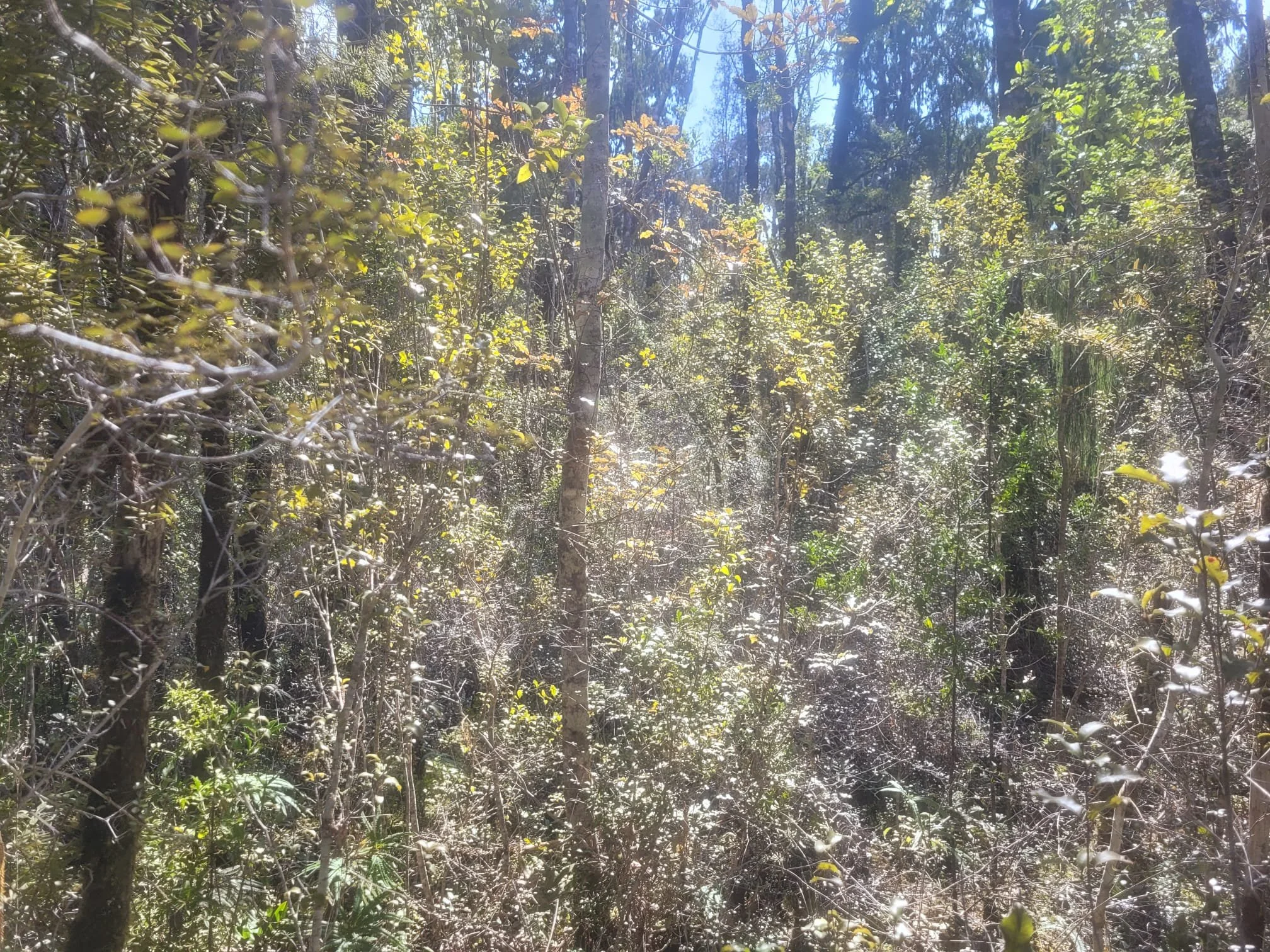Restoring forests and capturing carbon for a thriving future.
New Zealand’s native forests and tussock grasslands are powerful carbon sinks—but introduced wild animals like possums, rats, stoats and deer are damaging them, turning some of these ecosystems into a source of carbon emissions.
Data collected by the Ministry for the Environment and Department of Conservation shows that tall growth forests on the South Island’s West Coast could be losing as much as 1 tonne of carbon per hectare every year.
ZIP is pioneering new ways to measure how removing pests can boost carbon stocks (a process known as sequestration). Proving this link could unlock a cost-effective, nature-based solution to climate change—while restoring the health of our natural world.
What has happened so far?
Philanthropic investment from private donors, in addition to funding through New Zealand’s Predator Free 2050 mission, has enabled the first phase of research.
The research is being done in collaboration with scientists at the BioEconomy Science Institute and Earth Sciences New Zealand. It compares managed forests (where animal numbers are controlled) to unmanaged ones, using both standard vegetation survey methods and emerging measurement techniques to quantify carbon storage in relation to differing animal populations.
Aotearoa New Zealand faces two big challenges
Our native forests are in trouble. Animals that were brought here from other countries, like possums, deer, rats and stoats, are causing a lot of damage. Deer eat young trees, leaves, and seedlings, while predators like rats, stoats, and possums eat native birds, their eggs, and the insects they rely on. This is making it harder for forests to regenerate and for native birds to survive—about 25 million native birds are killed by introduced predators each year.
Climate change is happening now. Besides its effects on the environment and people, it's going to cost New Zealand a lot of money. To meet our international commitments to cut down on greenhouse gas emissions, we might need to spend up to $23.7 billion by 2030 just to buy carbon credits from other countries. Reaching our 2050 goals will be even harder and more expensive.
Could animal management in our native ecosystems help address the climate change challenge?
Forests and tussock grasslands store carbon
Carbon dioxide is a greenhouse gas. Trees and other plants such as tussocks absorb carbon dioxide from the atmosphere as they grow. Carbon dioxide is converted into carbon and stored in the plant's branches, leaves, trunks, roots and in the soil. This process, known as photosynthesis, facilitates carbon sequestration.
Introduced animals might be impacting carbon storage
The leaves of trees, shrubs and tussocks are the engine room of plant energy production. They allow plants to photosynthesise—turning sunlight, carbon dioxide, and water into oxygen, sugars, and carbon. Without leaves, this process can’t happen. When plants are stripped of their leaves (defoliated), they must use energy to grow new ones. If this happens repeatedly, the plant can eventually die.
While it is generally recognised that native vegetation and overall biodiversity rebounds as a result of managing introduced animals, there is currently limited evidence of a positive link between wild animal control and additional above-ground carbon storage.
Browsed kāmahi-podocarp forest in Weheka South (without animal management)
Regenerating kāmahi-podocarp forest in South Ōkārito (with animal management)
Several studies have looked at how much carbon native forests and tussock grasslands store, and how introduced animals affect that. But none have explored how these two things are connected when these ecosystems are managed intensively. Nor have they looked for small changes in carbon storage over a short time.
The New Zealand Natural Forest Inventory found that kāmahi-podocarp forests lost a significant amount of carbon—about 8 tonnes per hectare—between 2002 to 2012.
These forests are widespread, covering around 2 million hectares, or 29% of Aotearoa New Zealand’s native forests.
We don’t yet fully understand why this carbon loss is happening. But it's likely that browsing animals like possums, deer, and chamois are part of the problem. These animals eat leaves and young plants, which may reduce the forest’s ability to absorb carbon dioxide through photosynthesis. Since 2002, plant species that these animals like to eat have declined, while those they avoid have become more common.
Because of this, the Native Carbon Initiative is initially focusing the majority of our efforts on kāmahi-podocarp forests. We’ve begun research to see if we can measure small carbon changes, and show that they’re caused by controlling introduced animals.
If we can prove that managing wild animals helps native ecosystems store more carbon, it could bring significant economic benefits.
Under the Paris Agreement, New Zealand is allowed to count increases in carbon stored in older forests if those increases come from new management actions. That means we could count the extra carbon stored in forests where we remove animals like possums, rats and stoats, and manage deer numbers at a level that enables and promotes the regeneration of browsed native plants.
We’ve done some early economic calculations to figure out how much extra carbon a new animal control project would need to capture to be worth the cost. The findings showed that, over 25 years, each hectare of forest would need to store just 0.25 tonnes of extra carbon per year. That’s only 25 grams of carbon per square metre annually—about the same as 50 grams of wood. For kāmahi-podocarp forests, this is just a 0.1% increase in carbon each year. Because this change is so small, it’s not surprising that many traditional methods for measuring forest carbon can’t detect it reliably.
Even though that’s a very small amount, it could make a big difference if done across large areas of forest. Plus, based on current Treasury estimates, this method would cost about one-third as much as buying carbon credits from overseas.
The value of a carbon credit depends on the market where it is sold and the additional co-benefits that the credit encompasses, such as improved biodiversity values. The current New Zealand Emissions Trading Scheme price per emissions unit is NZ$55. On that basis, the 100,000 tonnes of carbon that we estimate has been sequestered as a result of intensive wild animal control under the Predator Free South Westland project would be worth $5.5 million.
So, can we prove a link between wild animal control and carbon storage? Not yet. But if we can, the benefits for New Zealand’s forests and taxpayers could be massive.
The New Zealand Native Carbon Initiative has three main goals:
1. Do research to find out if controlling introduced animals in native ecosystems really helps those forests sequester more carbon.
2. Develop a mechanism to enable investors to leverage the value of any additional carbon generated through intensive wild animal control.
3. Attract funding for both the research and animal control work, once the investment system is in place.
We are doing all three steps at the same time, because the problem is urgent and needs quick action.
We’re also using some advanced tools to detect small changes over short periods, including:
Remote sensing – we’re using satellite and drone imagery to identify and measure forest types. With the help of machine learning—a type of computer modelling where systems “learn” from patterns in large amounts of data—we can detect how many trees in a forest are dying and measure how this changes over time.
For tussock grassland measurement, we’re using a combination of remote sensing and plot-based sampling to estimate changes in above ground biomass in response to low (or zero) browsing.
Dendrometers – devices that measure microscopic changes in tree trunk size every 10 minutes and send their data remotely. This helps track trends in tree growth over time.
Carbon monitoring stations – NIWA's past research shows native forests absorb a lot of CO₂ - up to 60% more than has previously been calculated, even when browsing animals are present. With their assistance, we have installed equipment in South Westland that measures the carbon dioxide concentration in the air as it moves across forests. The air is first measured at the coast as it comes in “clean” off the ocean, and then again at a site 10km inland after the forest has had a chance to “take up” or sequester CO₂. Theoretically, the difference between the two measurements is what the forest has taken out of the atmosphere.
Tree coring – a method that removes a thin sample from a tree’s trunk to study its growth rings. This can show how tree growth has changed over time, with and without introduced animals or in response to major climatic events—and it doesn’t harm the tree. In North America and Europe, hundreds of thousands of tree core samples are taken as part of national forest inventory measurement programs, and this method is becoming more common in NZ.
There is some risk: we can’t guarantee the results.
The research required to demonstrate that managing animals in forests and tussock grasslands increases the amount of carbon stored is not straight forward.
As mentioned above, the potential change in carbon stock is relatively small compared with other methods of generating carbon such as planting of production forests.
Even if there is more carbon, we still have to be able to prove it was caused by the animal control efforts and not some other climatic or environmental effect.
How could this be paid for?
We’re working with government officials to come up with a way to attract sources of funding to support this research. This new funding system would:
Encourage people to invest in the research and development required to measure fine scale carbon stock changes and attribute this effect to intensive wild animal control
Let investors start new animal control projects in native ecosystems, whilst measuring potential changes in carbon storage
Guarantee that if the projects do lead to more carbon being stored, philanthropic investors can realise the value of this carbon through selling carbon credits with the goal of reinvesting this revenue into conservation
There is work to do to realise this opportunity
We know there are many questions that need answers, but the possible benefits are so big that it’s definitely worth trying.
We are thankful for the support we’ve received from a group of forward-thinking early investors.
“As the infinite cost of climate change reaches irreversible highs, now is the time for bold collective action.”



















